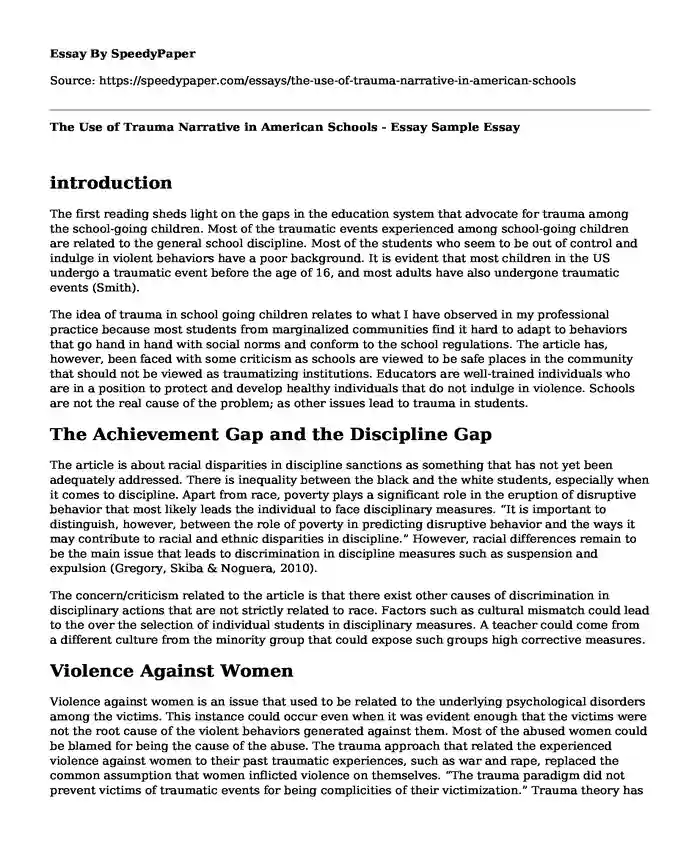introduction
The first reading sheds light on the gaps in the education system that advocate for trauma among the school-going children. Most of the traumatic events experienced among school-going children are related to the general school discipline. Most of the students who seem to be out of control and indulge in violent behaviors have a poor background. It is evident that most children in the US undergo a traumatic event before the age of 16, and most adults have also undergone traumatic events (Smith).
The idea of trauma in school going children relates to what I have observed in my professional practice because most students from marginalized communities find it hard to adapt to behaviors that go hand in hand with social norms and conform to the school regulations. The article has, however, been faced with some criticism as schools are viewed to be safe places in the community that should not be viewed as traumatizing institutions. Educators are well-trained individuals who are in a position to protect and develop healthy individuals that do not indulge in violence. Schools are not the real cause of the problem; as other issues lead to trauma in students.
The Achievement Gap and the Discipline Gap
The article is about racial disparities in discipline sanctions as something that has not yet been adequately addressed. There is inequality between the black and the white students, especially when it comes to discipline. Apart from race, poverty plays a significant role in the eruption of disruptive behavior that most likely leads the individual to face disciplinary measures. “It is important to distinguish, however, between the role of poverty in predicting disruptive behavior and the ways it may contribute to racial and ethnic disparities in discipline.” However, racial differences remain to be the main issue that leads to discrimination in discipline measures such as suspension and expulsion (Gregory, Skiba & Noguera, 2010).
The concern/criticism related to the article is that there exist other causes of discrimination in disciplinary actions that are not strictly related to race. Factors such as cultural mismatch could lead to the over the selection of individual students in disciplinary measures. A teacher could come from a different culture from the minority group that could expose such groups high corrective measures.
Violence Against Women
Violence against women is an issue that used to be related to the underlying psychological disorders among the victims. This instance could occur even when it was evident enough that the victims were not the root cause of the violent behaviors generated against them. Most of the abused women could be blamed for being the cause of the abuse. The trauma approach that related the experienced violence against women to their past traumatic experiences, such as war and rape, replaced the common assumption that women inflicted violence on themselves. “The trauma paradigm did not prevent victims of traumatic events for being complicities of their victimization.” Trauma theory has a variety of advantages when applied to the treatment of women who have been victims of violence. It helps to clearly understand that one did not inflict violence on themselves (Gilfus, 1999).
Criticism of the trauma paradigm is that the approach renders trauma to be an individual’s psychological response in its way to treat the psychological aftermath of a traumatic event. Trauma has replaced violence in being the leading cause of violence against women. This assumption is an aspect that leads to the failure in pointing out the real cause of violence against women as the theory makes it look as though violence can only result from past traumatic events, and there is no other underlying cause.
References
Gilfus, M. E. (1999). The price of the ticket: A survivor-centered appraisal of trauma theory. Violence Against Women, 5(11), 1238-1257.
Gregory, A., Skiba, R. J., & Noguera, P. A. (2010). The achievement gap and the discipline gap: Two sides of the same coin?. Educational Researcher, 39(1), 59-68.
Smith, D. A critical perspective on the use of the trauma narrative in American schools. Symbolic violence in socio-educational contexts, 24.
Cite this page
The Use of Trauma Narrative in American Schools - Essay Sample. (2023, Dec 24). Retrieved from https://speedypaper.com/essays/the-use-of-trauma-narrative-in-american-schools
Request Removal
If you are the original author of this essay and no longer wish to have it published on the SpeedyPaper website, please click below to request its removal:
- Free Essay with a Letter of Application Example
- Free Essay Investigating the Popularity of Western Education Establishments in China
- Essay Sample - The Invisible Victims: Prevalence of Domestic Emotional Abuse among Men
- Essay Sample: Impact of Technology Enhancement in Elementary School Classroom
- Free Essay. My Leadership Experience That Has Contributed to Group Efforts
- Prescription Drug Abuse: 49 US States Combat with PDMPs - Essay Sample
- Essay Sample on Analysis of Social Problem: Drug Abuse
Popular categories





